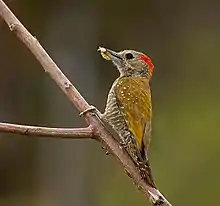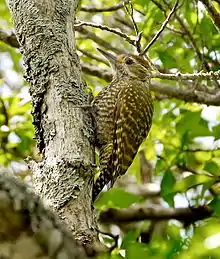Veniliornis
Veniliornis is a genus of birds in the woodpecker family Picidae. They are native to Central and South America.
| Veniliornis | |
|---|---|
 | |
| A male yellow-eared woodpecker (Veniliornis maculifrons) in Ilha Grande, Rio de Janeiro, Brazil. | |
| Scientific classification | |
| Domain: | Eukaryota |
| Kingdom: | Animalia |
| Phylum: | Chordata |
| Clade: | Dinosauria |
| Class: | Aves |
| Order: | Piciformes |
| Family: | Picidae |
| Tribe: | Melanerpini |
| Genus: | Veniliornis Bonaparte, 1854 |
| Type species | |
| Picus sanguineus[1] Lichtenstein, 1793 | |
| Species | |
|
see text | |
Taxonomy
The genus was introduced by the French ornithologist Charles Lucien Bonaparte in 1854.[2] The word Veniliornis combines the name of the Roman deity Venilia with the Greek word ornis meaning "bird".[3] The type species was designated as the blood-colored woodpecker (Veniliornis sanguineus) by the English zoologist George Robert Gray in 1855.[4][5]
The genus contains the following 14 species:[6]
| Image | Common Name | Scientific name | Distribution |
|---|---|---|---|
 | Scarlet-backed woodpecker | Veniliornis callonotus | Colombia, Ecuador and northern Peru |
.jpg.webp) | Yellow-vented woodpecker | Veniliornis dignus | Colombia, Ecuador, Peru, and Venezuela |
.jpg.webp) | Bar-bellied woodpecker | Veniliornis nigriceps | Bolivia, Colombia, Ecuador, and Peru. |
 | Little woodpecker | Veniliornis passerinus | South America east of the Andes |
.jpg.webp) | Dot-fronted woodpecker | Veniliornis frontalis | Argentina and Bolivia. |
 | White-spotted woodpecker | Veniliornis spilogaster | Brazil, Uruguay, eastern Paraguay and northeastern Argentina. |
_(cropped).jpg.webp) | Blood-colored woodpecker | Veniliornis sanguineus | Guyana, Suriname, and French Guiana |
.jpg.webp) | Red-rumped woodpecker | Veniliornis kirkii | Costa Rica south and east to Ecuador, Venezuela, Trinidad and Tobago |
.JPG.webp) | Red-stained woodpecker | Veniliornis affinis | eastern Brazil and the Amazon Basin. |
| Chocó woodpecker | Veniliornis chocoensis | Colombia and Ecuador. | |
.JPG.webp) | Golden-collared woodpecker | Veniliornis cassini | northern Brazil, the Guianas, Venezuela and far eastern Colombia. |
 | Yellow-eared woodpecker | Veniliornis maculifrons | eastern Brazil. |
 | Striped woodpecker | Veniliornis lignarius – formerly in Picoides[7][8] | southwestern South America. |
_(8077531219).jpg.webp) | Checkered woodpecker | Veniliornis mixtus – formerly in Picoides[7][8] | eastern South America. |
References
- "Picidae". aviansystematics.org. The Trust for Avian Systematics. Retrieved 2023-07-25.
- Bonaparte, Charles Lucien (1854). "Quadro dei volucri zigodattili ossia passeri a piedi scansori". In de Luca, Serafino; Müller, D. (eds.). L'Ateneo Italiano; raccolta di documenti e memorie relative al progresso delle scienze fisiche (in Italian). Vol. 2. Parigi [Paris]: Victor Masson. pp. 116–129 [125].
- Jobling, James A. (2010). The Helm Dictionary of Scientific Bird Names. London: Christopher Helm. pp. 399–400. ISBN 978-1-4081-2501-4.
- Gray, George Robert (1855). Catalogue of the Genera and Subgenera of Birds Contained in the British Museum. London: British Museum. p. 92.
- Dickinson, E.C.; Remsen, J.V., Jr., eds. (2013). The Howard & Moore Complete Checklist of the Birds of the World. Vol. 1: Non-passerines (4th ed.). Eastbourne, UK: Aves Press. p. 318. ISBN 978-0-9568611-0-8.
{{cite book}}: CS1 maint: multiple names: editors list (link) - Gill, Frank; Donsker, David (eds.). "Woodpeckers". World Bird List Version 6.2. International Ornithologists' Union. Retrieved 5 May 2016.
- Donegan, Thomas (January 2007). "Proposal (#262) South American Classification Committee: Transfer Picoides mixtus and P. lignarius to Veniliornis". American Ornithologists' Union. Retrieved 7 May 2016.
- Moore, W.S.; Weibel, A.C.; Agius, A. (2006). "Mitochondrial DNA phylogeny of the woodpecker genus Veniliornis (Picidae, Picinae) and related genera implies convergent evolution of plumage patterns". Biological Journal of the Linnean Society. 87 (4): 611–624. doi:10.1111/j.1095-8312.2006.00586.x.
This article is issued from Wikipedia. The text is licensed under Creative Commons - Attribution - Sharealike. Additional terms may apply for the media files.